Edelstein-Keshet L. Mathematical Models in Biology
Подождите немного. Документ загружается.

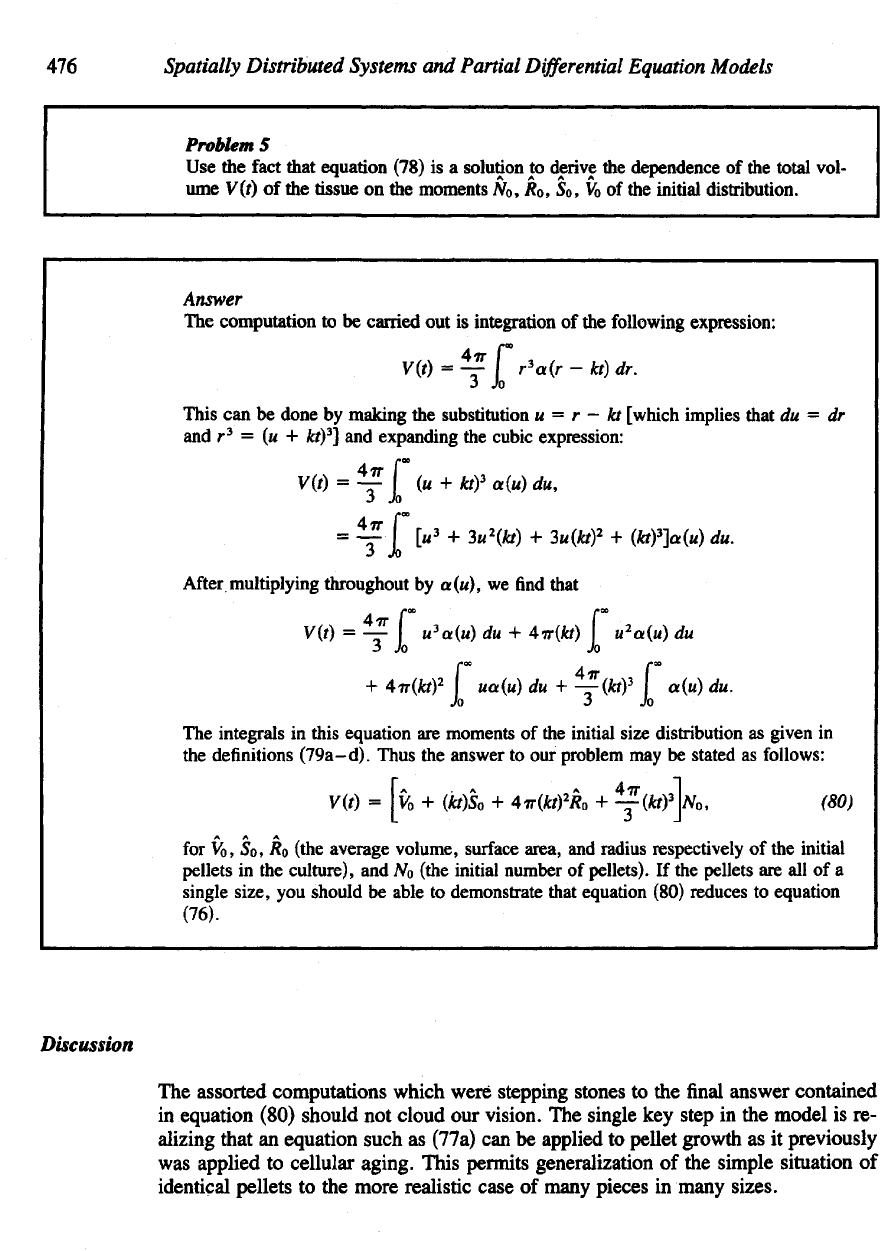
476
Spatially
Distributed
Systems
and
Partial
Differential
Equation
Models
Problem
5
Use the
fact that equation
(78)
is a
solution
to
derive
the
dependence
of the
total
vol-
ume
V(t)
of the tissue on the
moments
N
0
,Ro,S
0
,
V
0
of the
initial distribution.
Answer
The
computation
to be
carried
out is
integration
of the
following expression:
After
multiplying throughout
by
a(u),
we find
th
for
V
0
, So,
RO
(the
average volume, surface area,
and
radius respectively
of the
initial
pellets
in the
culture),
and N
0
(the
initial number
of
pellets).
If the
pellets
are all of a
single
size,
you
should
be
able
to
demonstrate
that
equation
(80)
reduces
to
equation
(76).
Discussion
The
assorted computations which were stepping stones
to the final
answer contained
in
equation (80) should
not
cloud
our
vision.
The
single
key
step
in the
model
is re-
alizing that
an
equation such
as
(77a)
can be
applied
to
pellet
growth
as it
previously
was
applied
to
cellular aging. This permits generalization
of the
simple situation
of
identical
pellets
to the
more realistic case
of
many
pieces
in
many sizes.
This
can be
done
by
making
the
substitution
u = r - kt
[which implies that
du = dr
and
r
3
= (u +
kt)
3
]
and
expanding
the
cubic expression:
The
integrals
in
this equation
are
moments
of the
initial size distribution
as
given
in
the
definitions
(79a-d).
Thus
the
answer
to our
problem
may be
stated
as
follows:
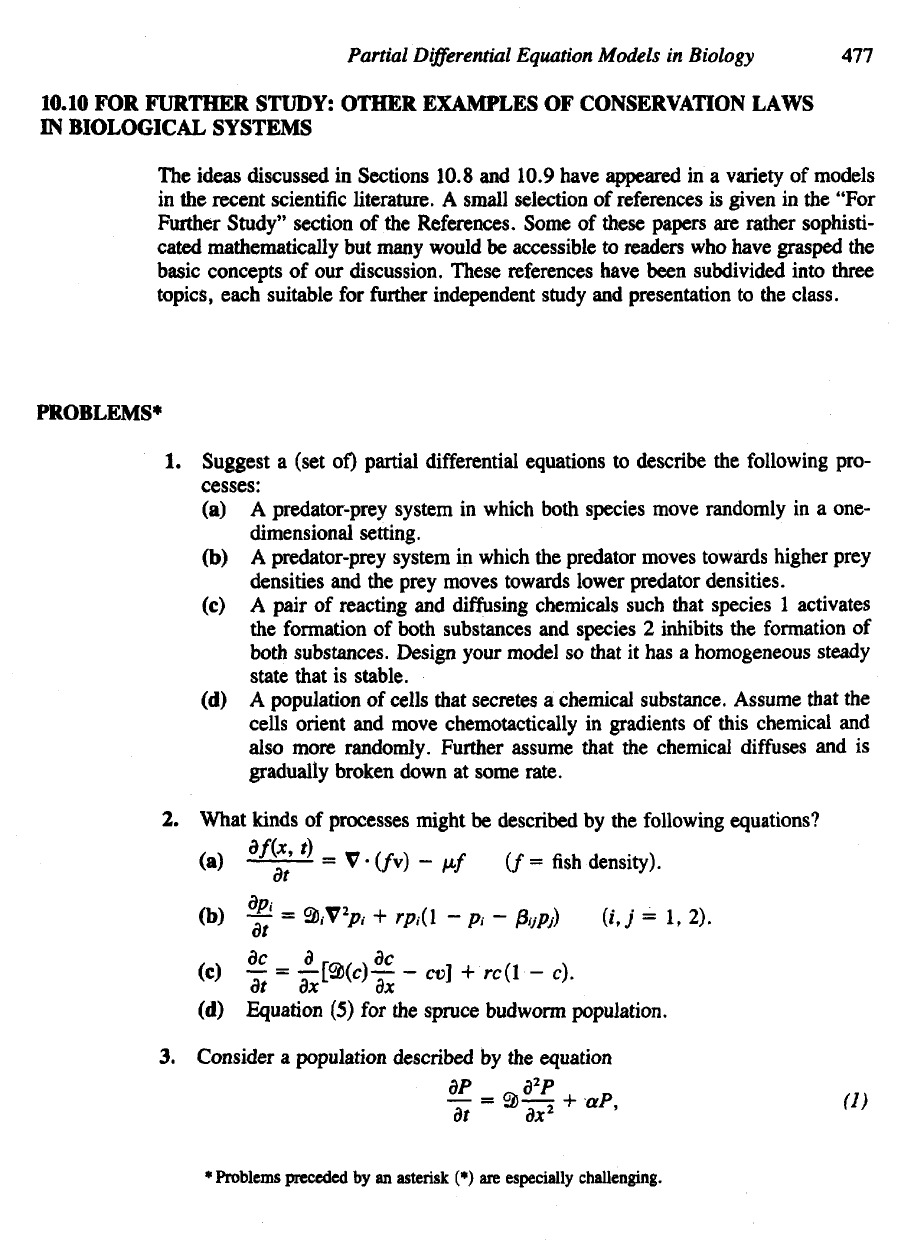
Partial
Differential
Equation
Models
in
Biology
477
10.10
FOR
FURTHER STUDY: OTHER EXAMPLES
OF
CONSERVATION LAWS
IN
BIOLOGICAL SYSTEMS
The
ideas discussed
in
Sections 10.8
and
10.9 have appeared
in a
variety
of
models
in
the
recent
scientific literature.
A
small selection
of
references
is
given
in the
"For
Further Study" section
of the
References. Some
of
these papers
are
rather sophisti-
cated mathematically
but
many would
be
accessible
to
readers
who
have grasped
the
basic concepts
of our
discussion. These references have been subdivided into three
topics, each suitable
for
further
independent study
and
presentation
to the
class.
PROBLEMS*
1.
Suggest
a
(set
of)
rtial
differential
equations
to
describe
the
following
pro-
cesses:
(a) A
predator-prey system
in
which
both species move randomly
in a
one-
dimensional
setting.
(b) A
predator-prey system
in
which
the
predator moves towards higher prey
densities
and the
prey moves towards lower predator densities.
(c) A
pair
of
reacting
and
diffusing
chemicals such that species
1
activates
the
formation
of
both substances
and
species
2
inhibits
the
formation
of
both substances. Design your model
so
that
it has a
homogeneous steady
state
that
is
stable.
(d) A
population
of
cells that secretes
a
chemical substance. Assume that
the
cells orient
and
move chemotactically
in
gradients
of
this chemical
and
also more randomly. Further assume that
the
chemical
diffuses
and is
gradually
broken down
at
some rate.
2.
What kinds
of
processes might
be
described
by the
following
equations?
3.
Consider
a
population described
by the
equation
*
Problems preceded
by an
asterisk
(*) are
especially challenging.
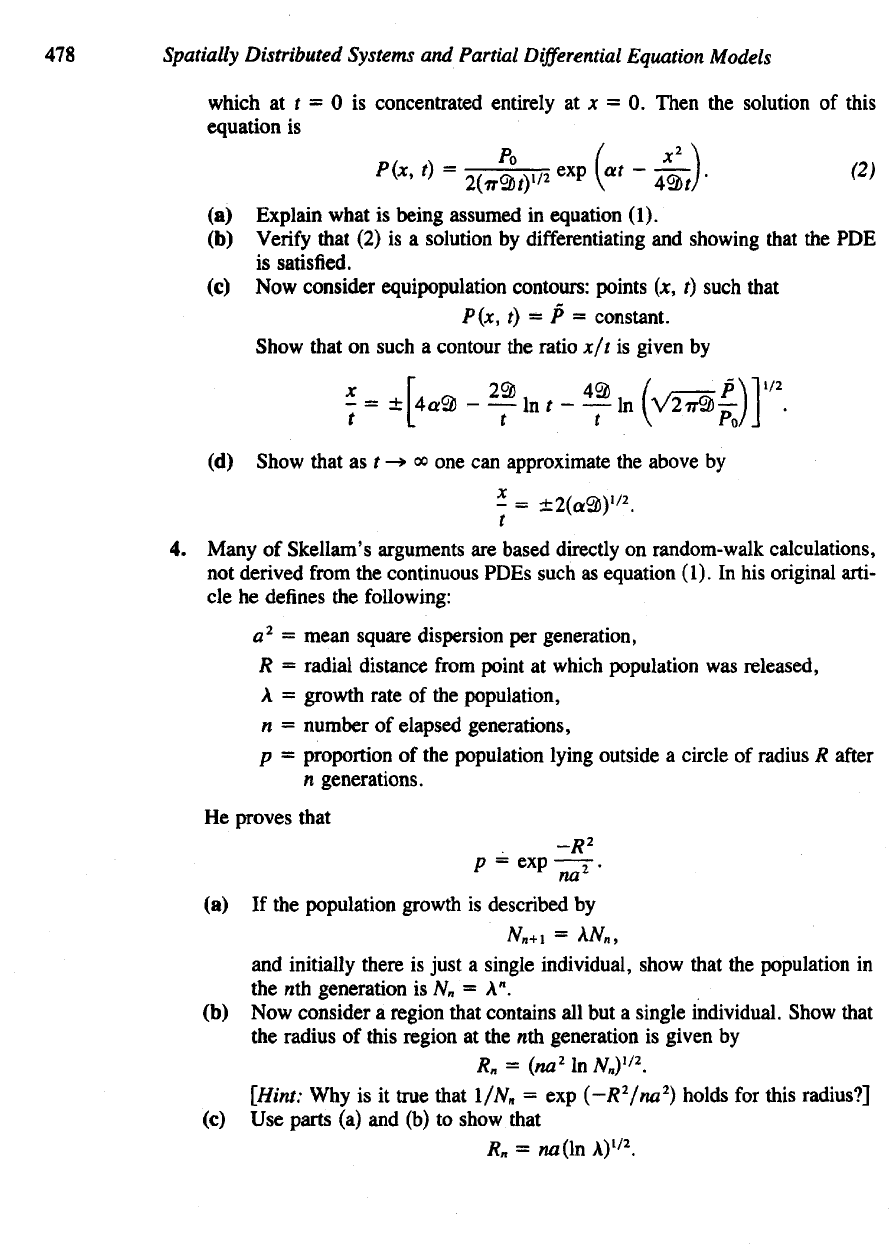
478
Spatially
Distributed Systems
and
Partial
Differential
Equation
Models
which
at t = 0 is
concentrated entirely
at x = 0.
Then
the
solution
of
this
equation
is
(a)
Explain what
is
being assumed
in
equation (1).
(b)
Verify
that
(2) is a
solution
by
differentiating
and
showing
that
the PDE
is
satisfied.
(c) Now
consider
equipopulation contours: points
(x, t)
such that
P(x,
t) - P =
constant.
Show that
on
such
a
contour
the
ratio
x/t is
given
by
(d)
Show that
as t -* oo one can
approximate
the
above
by
4.
Many
of
Skellam's
arguments
are
based directly
on
random-walk calculations,
not
derived
from
the
continuous PDEs such
as
equation (1).
In his
original arti-
cle he
defines
the
following:
a
2
=
mean square dispersion
per
ration,
R =
radial distance
from
point
at
which population
A
=
growth rate
of the
population,
n =
number
of
elapsed generations,
p
=
proportion
of the
population lying outside
a
circle
of
radius
R
after
n
generations.
He
proves
that
(a) If the
population growth
is
described
by
and
initially there
is
just
a
single individual, show that
the
population
in
the nth
generation
is N
n
= A".
(b) Now
consider
a
region that contains
all but a
single individual. Show that
the
radius
of
this region
at the nth
generation
is
given
by
[Hint:
Why is it
true that 1/M,
= exp
(-R
2
/na
2
)
holds
for
this
radius?]
(c) Use
parts
(a) and (b) to
show that
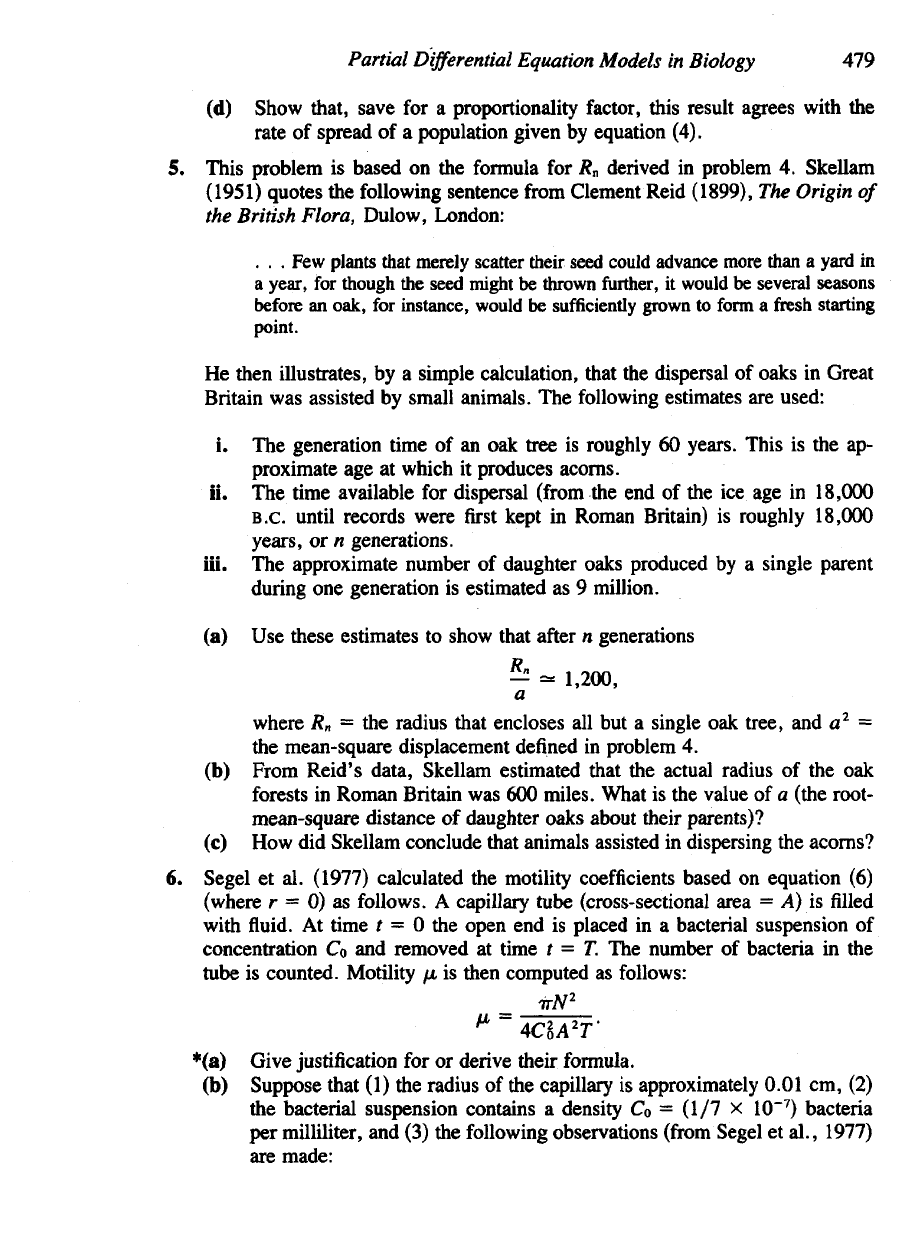
Partial
Differential
Equation
Models
in
Biology
479
(d)
Show that, save
for a
proportionality factor, this result agrees with
the
rate
of
spread
of a
population given
by
equation (4).
5.
This problem
is
based
on the
formula
for /?„
derived
in
problem
4.
Skellam
(1951) quotes
the
following sentence
from
Clement Reid (1899),
The
Origin
of
the
British Flora, Dulow, London:
.
. . Few
plants that merely scatter their seed could advance more than
a
yard
in
a
year,
for
though
the
seed might
be
thrown further,
it
would
be
several seasons
before
an
oak,
for
instance, would
be
sufficiently
grown
to
form
a
fresh starting
point.
He
then
illustrates,
by a
simple calculation, that
the
dispersal
of
oaks
in
Great
Britain
was
assisted
by
small animals.
The
following estimates
are
used:
i. The
generation time
of an oak
tree
is
roughly
60
years. This
is the ap-
proximate
age at
which
it
produces acorns.
ii. The
time available
for
dispersal
(from
the end of the ice age in
18,000
B.C.
until records were
first
kept
in
Roman Britain)
is
roughly
18,000
years,
or n
generations.
iii.
The
approximate number
of
daughter oaks produced
by a
single parent
during
one
generation
is
estimated
as 9
million.
(a) Use
these estimates
to
show that
after
n
generations
*(a) Give justification
for or
derive
their
formula.
(b)
Suppose that
(1) the
radius
of the
capillary
is
approximately 0.01
cm, (2)
the
bacterial
suspension contains
a
density
Co =
(1/7
x
10~
7
) bacteria
per
milliliter,
and (3) the
following observations
(from
Segel
et
al., 1977)
are
made:
where
R
n
= the
radius that encloses
all but a
single
oak
tree,
and a
2
=
the
mean-square displacement
defined
in
problem
4.
(b)
From
Reid's
data, Skellam estimated that
the
actual radius
of the oak
forests
in
Roman Britain
was 600
miles. What
is the
value
of a
(the root-
mean-square
distance
of
daughter oaks about their parents)?
(c) How did
Skellam conclude that animals assisted
in
dispersing
the
acoms?
6.
Segel
et al.
(1977) calculated
the
motility coefficients based
on
equation
(6)
(where
r = 0) as
follows.
A
capillary tube
(cross-sectional
area
= A) is filled
with
fluid. At
time
t — 0 the
open
end is
placed
in a
bacterial suspension
of
concentration
Co and
removed
at
time
t = T. The
number
of
bacteria
in the
tube
is
counted. Motility
/a, is
then computed
as
follows:

480
Spatially
Distributed
Systems
and
Partial
Differential
Equation
Models
2
5
10
12.5
15
1800
3700
4800
5500
6700
What
do you
conclude about
JJL?
7.
Segel
et al.
(1977) consider
the
following more detailed description
of
bacterial
motion. They point
out
that bacteria undergo
a
series
of
straight swimming
(with
average
speed
t?)
interrupted
by
random tumbles
in
which
the
orientation
is
changed. (See figure.)
The
mean
free
path,
A
(average length
of a
straight
swim)
and the
bacterial motility,
JJL
satisfy
the
following relationship.
[Lovely
and
Dahlquist
(1975)].
8. In
this problem
we
investigate several details
of a
model
for
bacterial motility
and
growth
proposed
by
Lauffenburger
et al.
(1981)
[see equations
(7a,b)].
(a) A
one-dimensional geometry
is
considered, with bacteria confined
to a
tube
of
length
L. In the
experiment
the
substrate level
at x = L is
kept
artificially constant
at
concentration
s
0
. At x = 0 the
tube
is
sealed.
What
are the
appropriate boundary conditions
on
b(x,
t) and
s(x,
t)l
(b) For the
reproductive rate
of the
bacteria,
G*, the
authors assume that
where
k is a
constant depicting frictional
effects.
(c) If T is the
mean time between turns, show that
/x can be
written
in
terms
of T as
follows:
Figure
for
problem
7. 4r
(a) Why is
this
a
reasonable assumption based
on
dimensional consider-
ations?
(b)
Suppose that
the
speed
v of a
cell
is
proportional
to the
force
F
that
drives
it
through
a fluid of
viscosity
n.
Show that
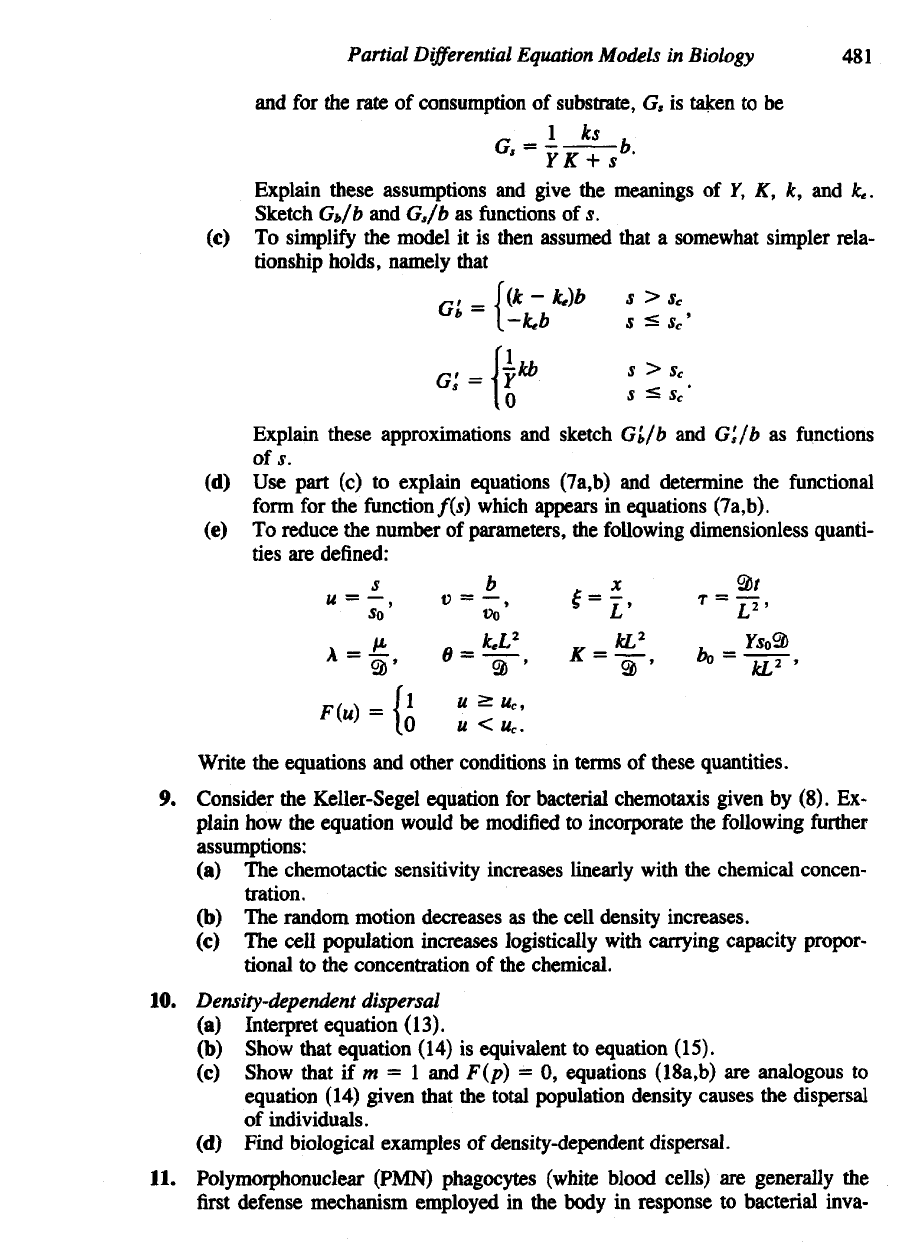
Partial
Differential
Equation
Models
in
Biology
481
and for the
rate
of
consumption
of
substrate,
G
s
is
taken
to be
Explain these assumptions
and
give
the
meanings
of Y, K, k, and k
e
.
Sketch
G
bib and
G
s
/b
as
functions
of s.
(c) To
simplify
the
model
it is
then assumed that
a
somewhat simpler rela-
tionship
holds,
namely that
Explain these approximations
and
sketch Gl/b
and
G'Jb
as
functions
of
s.
(d) Use
part
(c) to
explain equations (7a,b)
and
determine
the
functional
form
for the
function
f(s) which appears
in
equations (7a,b).
(e) To
reduce
the
number
of
parameters,
the
following dimensionless quanti-
ties
are
defined:
Write
the
equations
and
other conditions
in
terms
of
these quantities.
9.
Consider
the
Keller-Segel equation
for
bacterial chemotaxis given
by
(8).
Ex-
plain
how the
equation would
be
modified
to
incorporate
the
following
further
assumptions:
(a) The
chemotactic sensitivity increases linearly with
the
chemical concen-
tration.
(b) The
random motion decreases
as the
cell density increases.
(c) The
cell
population
increases
logistically with carrying capacity propor-
tional to the
concentration
of the
chemical.
10.
Density-dependent
dispersal
(a)
Interpret equation (13).
(b)
Show that equation (14)
is
equivalent
to
equation (15).
(c)
Show that
if m = 1 and
F(p)
= 0,
equations (18a,b)
are
analogous
to
equation (14) given that
the
total population density causes
the
dispersal
of
individuals.
(d)
Find
biological
examples
of
density-dependent dispersal.
11.
Polymorphonuclear (PMN) phagocytes (white
blood
cells)
are
generally
the
first
defense
mechanism employed
in the
body
in
response
to
bacterial inva-
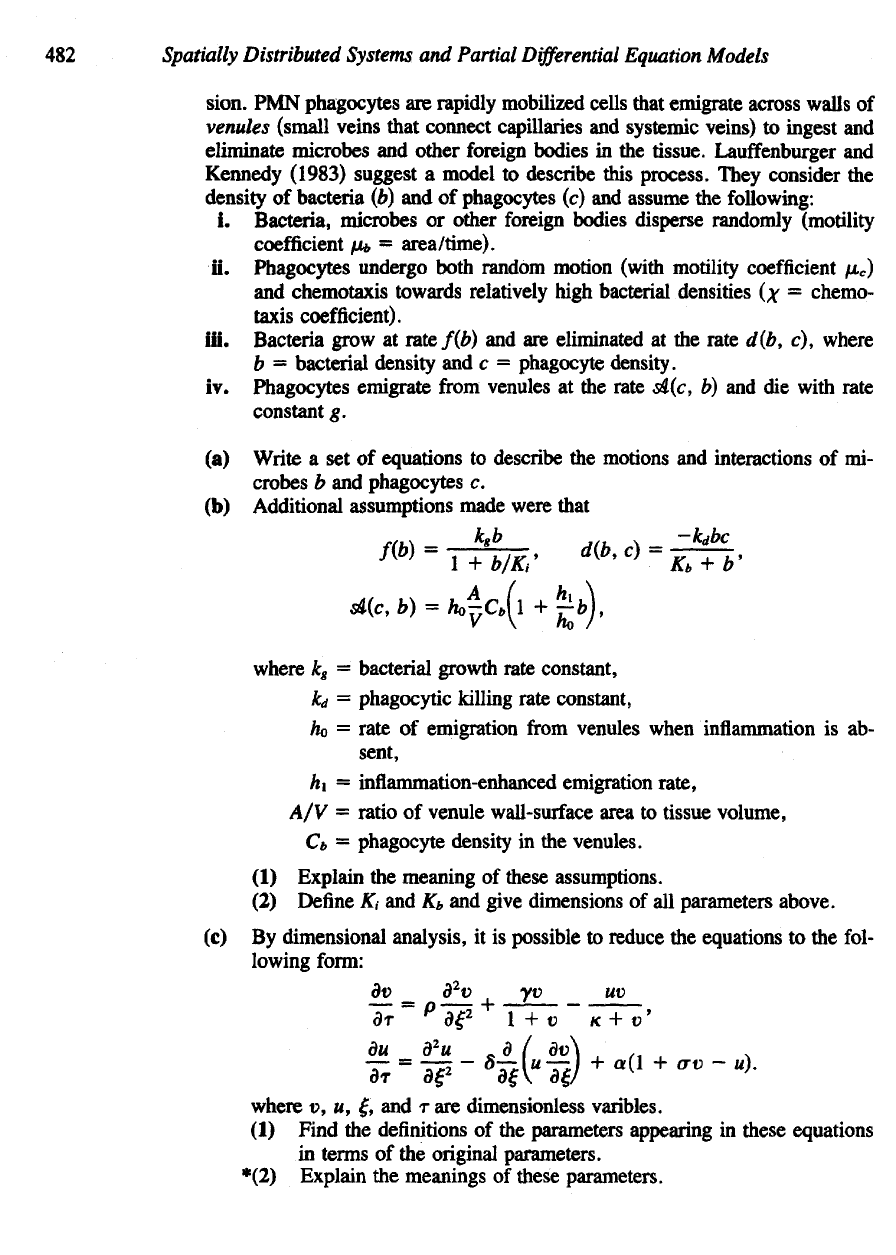
482
Spatially
Distributed
Systems
and
Partial
Differential
Equation
Models
sion.
PMN
phagocytes
are
rapidly mobilized cells that emigrate across walls
of
venules
(small veins that connect capillaries
and
systemic veins)
to
ingest
and
eliminate microbes
and
other foreign bodies
in the
tissue. Lauffenburger
and
Kennedy
(1983)
suggest
a
model
to
describe this
process.
They consider
the
density
of
bacteria
(b) and of
phagocytes
(c) and
assume
the
following:
i.
Bacteria, microbes
or
other
foreign
bodies disperse randomly (motility
coefficient
/** =
area/time).
ii.
Phagocytes undergo both random motion
(with
motility coefficient /u
c
)
and
chemotaxis towards relatively high bacterial densities
(x =
chemo-
taxis
coefficient).
iii. Bacteria grow
at
rate/(£)
and are
eliminated
at the
rate d(b,
c),
where
b =
bacterial
density
and c =
phagocyte density.
iv.
Phagocytes emigr ate sl(c,
b) and die
with rate
constant
g.
(a)
Write
a set of
equations
to
describe
the
motions
and
interactions
of mi-
crobes
b and
phagocytes
c.
(b)
Additional assumptions made were that
where
k
g
=
bacterial growth rate constant,
k
d
=
phagocytic killing rate constant,
ho
-
rate
of
emigration
from
venules when inflammation
is ab-
sent,
hi
=
inflammation-enhanced emigration rate,
A/V =
ratio
of
venule wall-surface area
to
tissue volume,
Cb
—
phagocyte density
in the
venules.
(1)
Explain
the
meaning
of
these assumptions.
(2)
Define
K
f
and K
b
and
give dimensions
of all
parameters above.
(c) By
dimensional analysis,
it is
possible
to
reduce
the
equations
to the
fol-
lowing
form:
where
v, u, £, and r are
dimensionless varibles.
(1)
Find
the
definitions
of the
parameters appearing
in
these equations
in
terms
of the
original parameters.
*(2) Explain
the
meanings
of
these parameters.
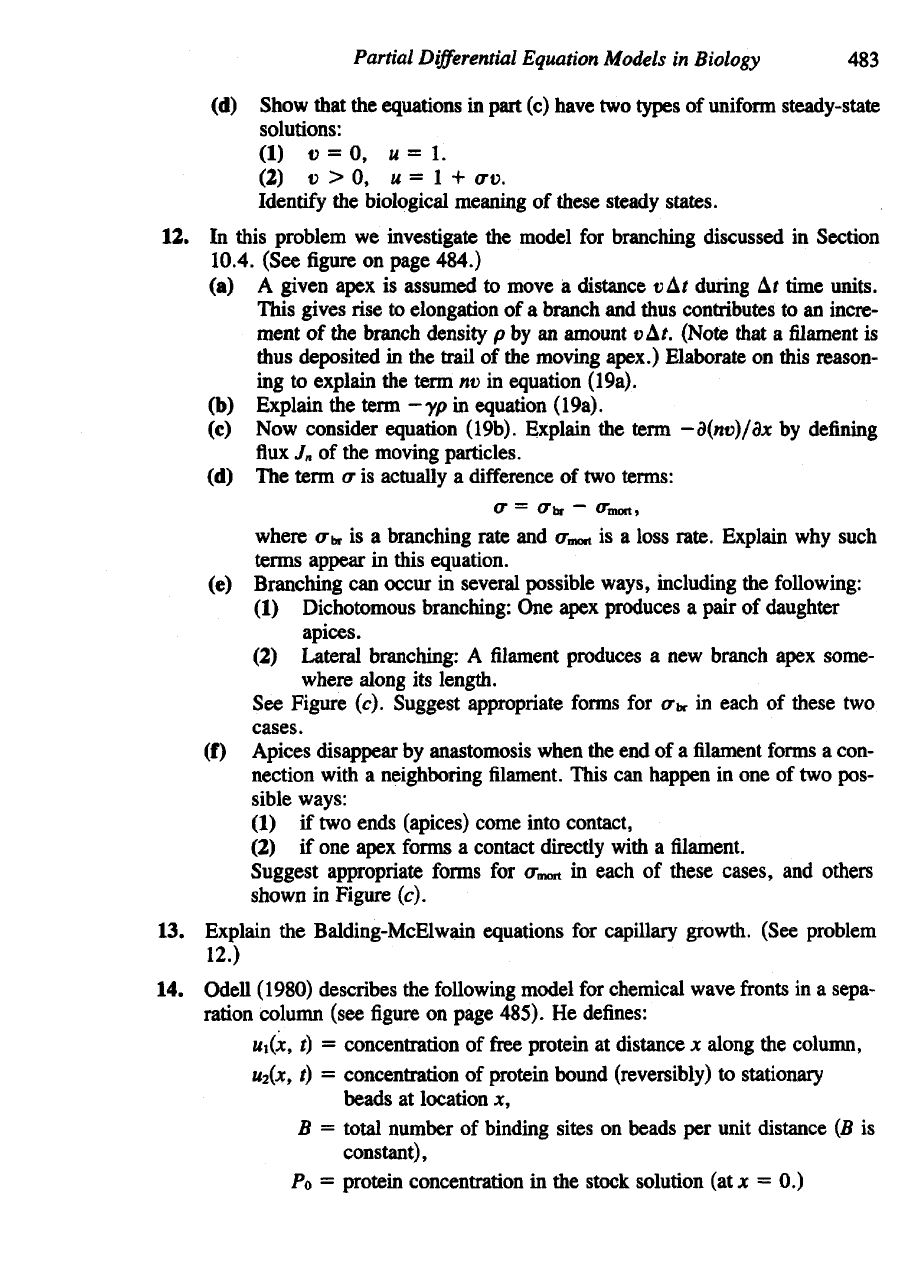
Partial
Differential
Equation
Models
in
Biology
483
(d)
Show that
the
equations
in
part
(c)
have
two
types
m
steady-state
solutions:
(1) t; = 0, u = 1.
(2)
t; > 0,
M
= 1 +
0-v.
Identify
the
biological
meaning
of
these steady states.
12. In
this problem
we
investigate
the
model
for
branching discussed
in
Section
10.4. (See
figure
on
page 484.)
(a) A
given apex
is
assumed
to
move
a
distance t;Af during
Af time
units.
This
gives
rise
to
elongation
of a
branch
and
thus contributes
to an
incre-
ment
of the
branch density
p by an
amount
u
Af.
(Note that
a filament is
thus
deposited
in the
trail
of the
moving apex.) Elaborate
on
this reason-
ing to
explain
the
term
nv in
equation (19a).
(b)
Explain
the
term
-yp in
equation (19a).
(c) Now
consider equation (19b). Explain
the
term -d(nv)/dx
by
defining
flux
J
n
of the
moving particles.
(d) The
term
cr is
actually
a
difference
of two
terms:
ff
—
O"br
~
O"mort,
where
cr* is a
branching rate
and ow is a
loss rate. Explain
why
such
terms appear
in
this equation.
(e)
Branching
can
occur
in
several possible s, including
the
following:
(1)
Dichotomous branching:
One
apex produces
a
pair
of
daughter
apices.
(2)
Lateral branching:
A filament
produces
a new
branch apex some-
where along
its
length.
See
Figure (c). Suggest appropriate
forms
for ov in
each
of
these
two
cases.
(f)
Apices disappear
by
anastomosis when
the end of a filament
forms
a
con-
nection
with
a
neighboring
filament.
This
can
happen
in one of two
pos-
sible ways:
(1) if two
ends (apices) come into contact,
(2) if one
apex
forms
a
contact directly
with
a filament
Suggest
appropriate
forms
for ow in
each
of
these
ca
and
others
shown
in
Figure (c).
13.
Explain
the
Balding-McElwain equations
for
capillary growt (See problem
12.)
Odell (1980) describes
the
following
model
for
chemical wave
fronts
in a
sepa-
ration column (see
figure on
page 485).
He
defines:
u\(x,
t) —
concentration
of
free
protein
at
distance
x
along
the
column,
it2(x,
i) =
concentration
of
protein bound (reversibly)
to
stationary
beads
at
location
x,
B =
total number
of
binding sites
n
beads
per
unit distance
(B is
constant),
Po
=
protein concentration
in the
s ck solution
(at x = 0.)
14..

484
Spatially
Distributed
Syst
and
Partial
Differential
Equation
Models
Figure
for
problem
12.
Equation (19a,b)
can be
derived
by
considering changes
in
length
of
branches
and in the
numbers
of
apices
at a
given
location,
as
shown
in (a) and
(b).
The
branching
term
a
would contain terms that account
for
the
biological
events shown
in
(c). [From Edelstein,
(1982).
The
propagation
of
fungal colonies.
A
model
for
tissue
growth.
J.
Theor.
Biol.,
98, fig. 1
and
Table
1.
Reprinted
by
permission
of
Academic
Press.]
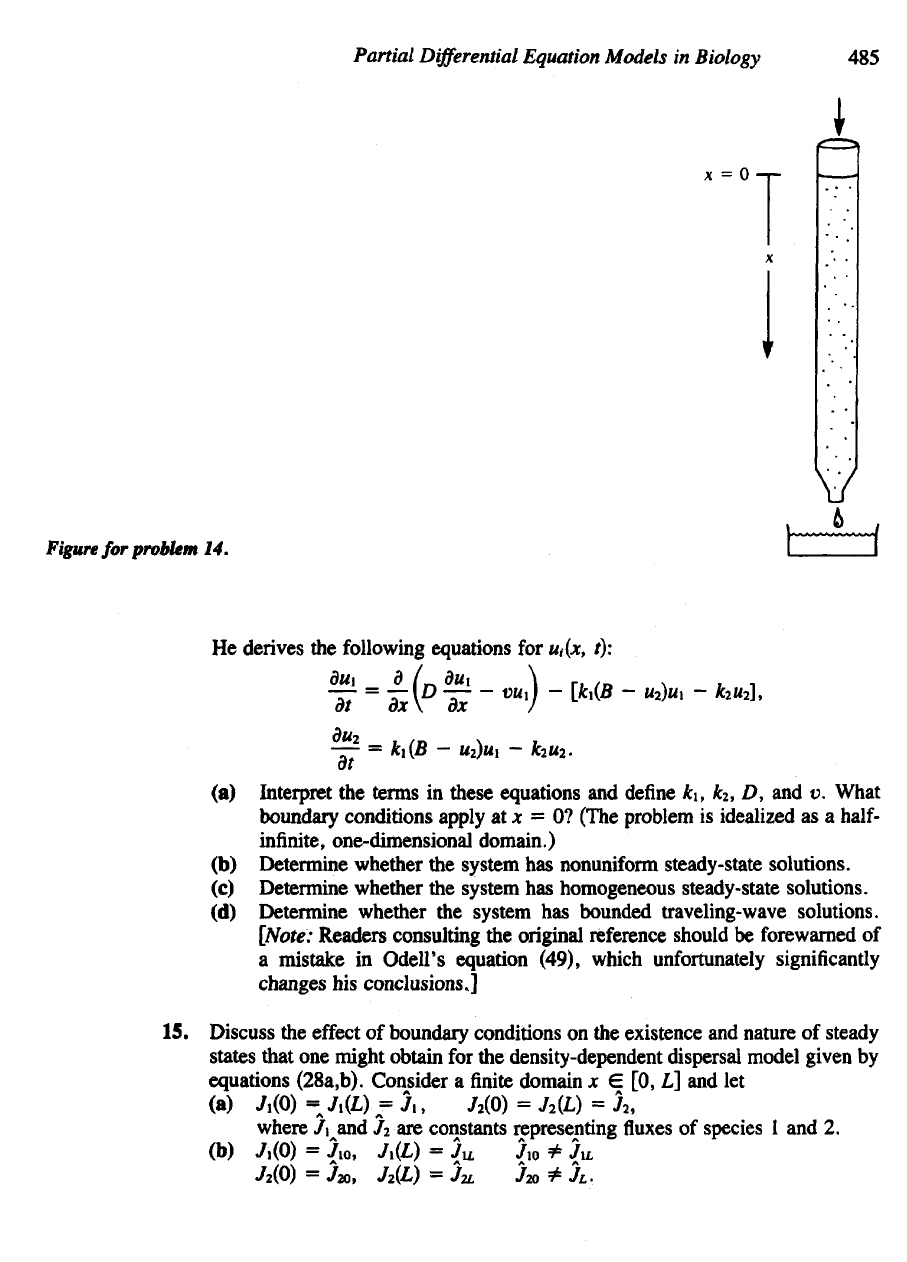
Partial
Differential
Equation
Models
in
Biology
485
Figure
for
problem
14.
He
derives
the
following equations
for
u,(x,
t):
(a)
Interpret
the
terms
in
these
equations
and
define
k\
t
k
2
, D, and v.
What
boundary
conditions
apply
at x - 0?
(The problem
is
idealized
as a
half-
infinite,
one-dimensional
domain.)
(b)
Determine whether
the
system
has
nonuniform
steady-state solutions.
(c)
Determine whether
the
system
has
homogeneous steady-state solutions.
(d)
Determine whether
the
system
has
bounded traveling-wave solutions.
[Note:
Readers consulting
the
original reference should
be
forewarned
of
a
mistake
in
Odell's
equation (49), which unfortunately significantly
changes
his
conclusions.]
15.
Discuss
the
effect
of
boundary
conditions
on the
existence
and
nature
of
steady
states that
one
might obtain
for the
density-dependent dispersal model given
by
equations (28a,b). Consider
a
finite
domain
x E [0, L] and let
(a)
/,(0)
=
JiCL)
= >..
Ji(0)
= ML) = J
2
,
where
J\ and J
2
are
constants representing
fluxes of
species
1 and 2.
(b)
7,(0)
=
J
10
, y,(L)
=
JIL
jfio
* Ju.
JM =
^20, J
2
(L)
=
JZL
J**J
L
..
